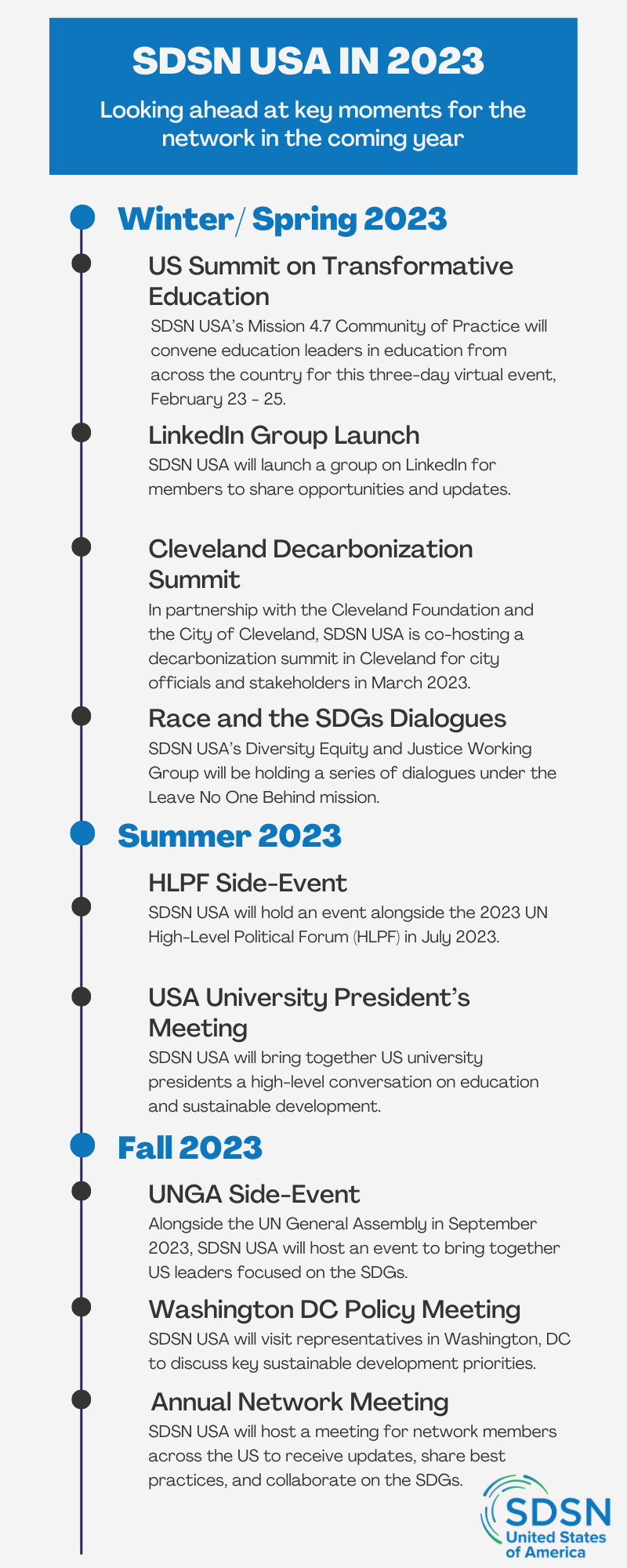Background
Global Context
The Sustainable Development Solutions Network spans six continents and draws upon the knowledge and educational capacity of more than 1,700 member institutions. Each individual network identifies priorities, determines working modalities, and develops initiatives based on the particular needs of their geography and the interests of their leadership and members. These networks activate the collective capacity of knowledge institutions towards sustainable solutions, governance, and systems change.
Network Activities To-Date
Over the past four years, SDSN USA has built an active and engaged community of partners and members to develop collaborations toward SDG research, education, policy, and localization. Along with SDSN’s SDG Transformation Lab, SDSN USA has released analyses on the state of the SDGs in the United States, including city- and state-level SDG indices as well as reports on unequal SDG delivery across race and class dimensions. Collaborating with SDSN’s Climate and Energy Program, the network produced America’s Zero Carbon Action Plan, a nationwide pathways analysis and policy recommendations to achieve net zero emissions, and is now working with members and partners to localize this work at county and city levels. Its four member-led working groups are working to build momentum around specific SDGs through collaborative reports, dialogue series, conferences, and more. SDSN Youth USA was launched, and efforts are underway to strengthen that program’s capacity. Monthly networking opportunities provide opportunities for members to engage with each other and the SDSN USA team, and regular feedback is collected to assess network health, and priorities and strategy adjusted to align with emerging opportunities and political shifts. Highlights from SDSN USA’s initiatives in 2022 are outlined here.
National Context and Opportunities
While the U.S. National Government has yet to complete a Voluntary National Review (VNR) or align national policies and priorities with the SDGs, local leaders and communities are innovating to advance the goals. At the midpoint of the SDGs, 2023 is a critical year for the SDGs in the United States. With its strong (and growing) base of engaged members and partners and lessons learned from prior collaborative initiatives, SDSN USA is well-positioned to take a leadership role in mobilizing towards the SDGs in the United States. This strategy outlines SDSN USA’s objectives and key activities proposed to meet this opportunity to advance the SDGs in the United States.
Governance & Structure
SDSN USA is the largest of SDSN’s 50 networks, comprising over 10% of global membership. As of December 2022, its members include 180 institutions in 46 states, Puerto Rico, the Virgin Islands, and Washington, DC. It launched in December 2018 and currently has three co-chairs: Helen Bond (Howard University); Gordon McCord (University of California, San Diego); and Jeffrey Sachs (SDSN and Columbia University). The network’s Leadership Council consists of 25 senior leaders from the public, private, and philanthropic sectors. The SDSN team includes Caroline Fox, Head of SDSN USA, and Sonja Neve, Program and Outreach Coordinator.
SDSN USA Mission and Vision
Vision: A society in which all people have what they need, and which provides for future generations to have the same
Mission: The SDSN USA endeavors to build pathways to achieving the UN Sustainable Development Goals in the United States by mobilizing research, outreach, and collective action.
2023 Objectives
SDSN USA is well-positioned to respond to the critical and fast-approaching midpoint SDG milestone moments. Over the next year, SDSN USA will prioritize the following objectives:
Advance the SDGs as a national priority in the United States
Support member-led SDG pathways and initiatives
Increase network visibility and impact
As a primary objective, SDSN USA aims to advance the SDGs as a national priority in the United States. Capitalizing on the politically opportune moments of 2023, the network can and must produce national engagement, policy recommendations, and collaborations lifting up local successes to advance priorities at scale. In the absence of national government coordination, the focus will be on facilitating connectivity, information sharing, and systems-level thinking across the country, towards products and events that can build national level dialogue and add value in the case that a VNR or other government actions are taken up.
Second, the network will support member-led SDG pathways and initiatives. This includes continuing to engage with existing working groups and communities of practice and responding to interests and opportunities where members identify potential to add value and step up to lead. The SDSN USA team provides these initiatives with project management, communications, and events/facilitation support. Over the next two years, SDSN USA will prioritize co-fundraising with these groups to increase the capacity, quality, and impact of these projects, encourage more targeted projects to be developed with defined impacts, and continue to build audience and engagement around member priorities.
Finally, SDSN USA will seek to increase network visibility and impact. To the benefit of USA network members, SDSN’s global network, and in pursuit of advancing the SDGs and Paris Climate Agreement, the network will hold a series of in-person and virtual convenings that engage leaders across sectors and connect across local and national scales. Network leadership and initiatives will produce thought leadership on progress and recommendations on the SDGs in the US.
Core Activities
To achieve the three primary objectives, SDSN USA will focus on: (1) prioritizing systems-level initiatives that bridge geographic or knowledge silos towards the development of scalable solutions; (2) fundraising and support of impactful member- and SDSN-led initiatives; (3) convening high-quality events, both virtually and in person, that capitalize on opportune moments of impact; (4) deepening relationships with local and national changemakers; and (5) strengthening network engagement and diversity through effective, high quality, and targeted engagement and communications. These activities will fortify the membership base, hone in and build on what’s worked to-date, and focus activities more acutely on where this program can add value to advance the SDGs in the United States.
Initiatives
SDSN USA has seven current initiatives. This includes:
Three member-led working groups: Zero Hunger; Mission 4.7; and Diversity, Equity and Justice
Two areas of work with leadership from other SDSN teams: Zero Carbon Consortium and Tracking Progress on the SDGs in the United States
Two focus areas “in development”: SDG Localization and SDSN Youth USA
Activities and new initiatives will require clear funding streams, priorities, strong leadership, and impact statements to be considered. Support for existing initiatives will continue, and at project inflection points, the SDSN USA team’s role will be streamlined, with an increased focus on fundraising and clearly defined project impacts in alignment with the core activities and objectives outlined above. A working matrix of SDSN USA initiatives is included at the end of this document and outlines leadership, priorities, activities, and the most relevant SDGs for each initiative.
Milestone Events
Regular/monthly networking opportunities and working group convenings will continue to be held throughout 2023, as a mechanism to streamline member connectivity with the SDSN USA team, build community, and respond to member feedback. In addition, in alignment with key UN and SDSN activities, the following core events are proposed and in development:
2023 Events:
Annual Network Meeting
HLPF Side-Event
UNGA Side-Event
Washington DC Policy Meeting
USA University President’s Meeting
LinkedIn Group Launch
US Transforming Education Summit
Cleveland Decarbonization Summit
Race and the SDGs Dialogues
US City Index Launch (tentative)
Key Performance Indicators (KPIs)
Success of this strategy will be measured by: steady year-on-year audience growth and event attendance rates, event and annual focal point survey responses, number of partnerships and active members, fundraising dollars raised, and self-evaluation of impact on local to national, scalable, and systems-level activation towards SDG achievement

